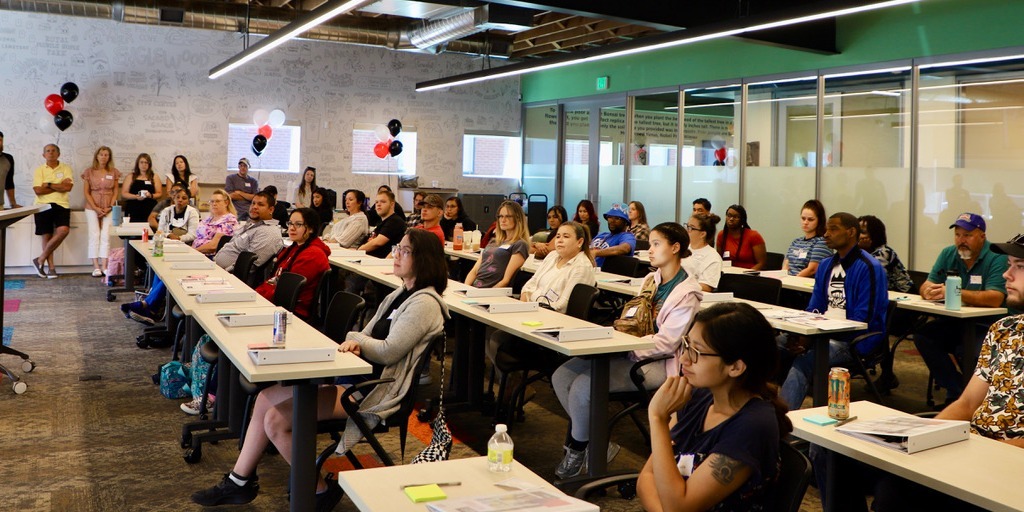Innovation in healthcare can take many forms, but it generally involves developing and implementing new technologies, methods, or ideas that improve the quality, efficiency, or effectiveness of healthcare delivery to enable value-based outcomes.
In our recent episode of The Health/Tech Edge, Eric Daiter, Manager Market Strategy and New Ventures at Catalyst by WellStar, joined us to speak about innovation that’s occurring within the healthcare industry and Catalyst, and how other mid-large organizations can take advantage of these opportunities. Watch the full interview here or read the summarized conversation below to learn more about:
- Why Catalyst by WellStar is successful at innovating healthcare solutions.
- The importance of finding the perfect balance between patient experience and effective care, while creating operational efficiency within the healthcare system.
- The growing focus on connecting platforms and finding operational efficiencies to enable predictive care.
- Finding the balance between cutting-edge and fundamental, well-executed technologies is crucial for innovation in healthcare.
- And more
Zoe Jacobs: Today we're going to talk about innovation in healthcare. Catalyst by WellStar is a really interesting organization. It's a hospital system that created this innovation arm. Eric, can you tell us what struck you about Catalyst by WellStar? Why did you choose to join such a unique company?
Eric Daiter: My background has been in growth, anything having to do with affecting change within healthcare and a piece of why Catalyst by WellStar is so intrinsically successful is because it's coming from within the hospital system. WellStar can come up with the most important problems that it's seeing within its hospitals, like post-acute, ERs, etc., and its healthcare facilities create that list and then directly affect the change by either finding people who are working on it now or creating that solution. So it's been an awesome experience to work with a healthcare provider who is actively trying to solve some of these problems.
Raheel Retiwalla: That's really interesting, Eric. I think the idea of growth, when coupled with the opportunities in healthcare to drive efficiencies, care management, etc., is really powerful. Healthcare hasn't traditionally looked upon that as such. There's always this thing about being more efficient at providing care and driving costs down but then on the other side of the equation, of course, is growth and profitability. So like at Catalyst, we've seen this occur at many other organizations on the payer and provider sides. As more payors think about what end-to-end care delivery means, there are areas and opportunities for innovation and growth there. I'm curious how much growth conversations drive that and what it really means.
Eric Daiter: Great question. From a healthcare perspective, growth means something totally different than a different innovation arm. For us, it's truly focused on patient care. If you look at the healthcare industry specifically in the United States, in some ways innovation that we're seeing in other industries skipped us. There are processes, operational efficiencies, and technology that are being used across the healthcare system that's not in tandem with what you're seeing in other groups, just because of regulation since it involves patients' lives.
There are multiple regulatory bodies that are involved. What I'd imagined for the larger healthcare industry growth is really involved in finding the perfect relationship between the patient experience and providing effective care. Sometimes it's not always in tandem. Patients want this seamless experience, they want one place where they can go for all of their remedies. They want efficient and effective care. If you look across the US healthcare system, those patient intricacies aren't always being hit on. So for us, growth is not necessarily growing our presence, it’s obviously an important factor, but it's more about how we grow into the future by finding these perfect patient experiences and create operational efficiency within our healthcare system.
Raheel Retiwalla: That's a great way to put it. I think it adds a lot of context to the role of innovation within healthcare itself which actually makes you question the amount of technology that continues to be available in healthcare, whether it might be just the role of Artificial Intelligence, Intelligent Automation, home care medical devices, or variables. The spectrum of innovation is extensive. In some ways, I feel there's a shift to being more race to the top type approach where how do we get, how do we identify, you know, what are the components that when put together, can drive, can drive this growth?
The challenge of course is that there's an element of what can really actually stick with humans that are involved in providing the care or receiving the care. How do you balance this rate of innovation, which is speeding up, and then in the end, actually it's humans that have to consume this and actually do things with, right?
Eric Daiter: When we bring up things like automation, we bring up things like machine learning. These are cutting edge technologies that you're seeing in industries who have had steady and rapid innovation all throughout the nineties, all throughout the 2000s. Healthcare is still in its fundamentals, needing focus on connecting platforms, finding operational efficiencies within connected healthcare systems, working with payer providers to most effectively create predictive care. So obviously the new cutting-edge technology is something we'll probably start to see within clinical care settings within the next five to ten years. But when we're thinking about some of these new innovations, and to the founders out there who are potentially coming up with these ideas, learn the industry. Find your customer discovery because I think what's interesting about healthcare, and you see this in other highly regulated, people-focused industries, there's tons of different players.
There's tons of these different pieces that are connected to solving a problem. Sometimes it's the simple solutions, those fundamental, well executed technologies, either platforms or connected services that are the real need for hospital systems and healthcare systems. Let's throw machine learning and AI into surgery rooms. It's all amazing work and it's things that are really important that we're going to see benefit surgeons and hospital groups. But I think there has to be a group focused on creating those fundamentals as well.
Raheel Retiwalla: We actually had Dr. Arif Nazir, who's the Chief Medical Officer from BrightSpring Health Services on The Health/Tech Edge and this is really his feedback. Which is, at the end of the day, I need my team to have better training, better tools to actually help them do what they need to do day in and day out. We need to think about the leapfrogging that could be happening using technology and innovation. The spectrum of capabilities and opportunities is tremendous. You hear about disease management, sensor technologies and you hear about MedTech. It’s that balance that entrepreneurs and founders have to think about and understand in healthcare. How will I land this today? Where can I make an impact today and how can I build on top of that over time?
Eric Daiter: That's a unique thing as well about both the healthcare industry and Catalyst by WellStar. For example, if you look at the average surgeon, let's say their job is to obviously keep patients alive. They go into their surgeries, patient care is their main focus and giving them an easier experience on how to do that is sometimes an ambiguous challenge.
There are tons of different ways you can do it. You can put more technology in the operating room as an example. You can give them greater, more efficient tools to better do their job. But I think what's really important for us is creating that list of the top challenges. So instead of coming from an outside and trying to fit a square peg into a round hole with what you're seeing in other industries, there are very unique and intrinsic challenges that the healthcare industry is seeing across its different partners. Just finding those challenges, creating that list, and then working on those specifically and knocking it off the list, doing your customer discovery, these are the things that are going to enable change over the next 5-10 years.
Raheel Retiwalla: When it comes to WellStar, it's a relatively large healthcare system. I'm curious about your thoughts on the health systems that are not large, even 6-8 hospitals. How can they participate in this journey when they're still struggling? There's tons of gaps and areas for opportunity. In fact, we had Safi Mansoor of UMass Memorial Medical Center on our show who talked about the organization not being able to take advantage of data and analytics to satisfy the needs of the various stakeholders. What would you recommend for the mid and smaller size health systems? How can they participate in this journey like you are right now?
Eric Daiter: Even at a larger scale, it’s always going to be a question, especially when patient lives are being affected by some of the solutions that you're testing. So in my suggestion, the first step is to get that executive buy-in. You need leadership to see that change is necessary and intrinsic to moving forward. Then with that buy-in, create a testing ground. There are tons of founders who are creating various solutions, who are trying to connect various services and sometimes, it's not the easiest from a software perspective because of the nature of how things like EHRs connect with each other.
Raheel Retiwalla: In my opinion, create the testing ground within your facilities in a safe and repeatable way for potential either startups, softwares, hardware developments to come into your facility, try something out, come in with a specific set of KPIs that they are going to hit on, whether it's some KPI involving patient care or time spent. It doesn’t always have to be a cost thing. It can also just be about how you are benefiting the actual patient and clinical provider.
Eric Daiter: Very true. This is a model that's effectively been adopted and done in other industries pretty well. So there's certainly parallels to being able to take and run with it. I think there is really an opportunity for Catalyst and organizations like Catalyst to help play a role there, to be able to convey these ideas and be able to talk about how best to operationalize these things and what it takes to do that.
It’s an interesting problem because you obviously run a certain financial risk which comes with any sort of investment. You're risking the experience of the patient. So just doing that customer discovery, making sure you have the correct research and what KPIs you'd like to focus on and then working with vendors to figure out who's the right solution to do this and then executing it in a small demo environment, I think that's the incremental change that's needed.
Raheel Retiwalla: If you're going to start doing innovation in healthcare, what I want to know is where are the areas of opportunity for healthcare disruption that you're seeing? Where are you focusing on innovation and disruption at Catalyst by WellStar?
Eric Daiter: So operational efficiency. Catalyst by WellStar has a specific set of genres of innovation that they're looking for from digital health and operational efficiencies. Those are all detailed within our strategy. From my personal opinion, from an industry perspective, anything operational efficiency-related such as connected services, improving UX and UI of current tools and providing efficiency for how doctors and clinical representatives are interacting with those tools and how it's connected to other software systems.
Any sort of automation, machine learning, that can be incorporated into the practicing of care, that's essential as well. I think it's an interesting time because technology is finally catching up with the rate of change. Before, we had systems that are a bit clunky, you would need to get sign off from those regulatory bodies. Now we're seeing tons of success from both a software and a hardware perspective in industries that are in tandem to healthcare. And now, in my opinion, you're going to see those same innovations start to trickle in and really take hold within some of these clinical providers. I think it's going to be a really interesting time to see some of this change over the next couple of years.
Stay Ahead of Trends and Technology Innovation in Healthcare
It is important to continue addressing workforce challenges and to build pathways for education institutions that prepare individuals for careers in healthcare. Addressing the disconnect between corporate partners, care providers, and innovators allows those in healthcare and technology to problem solve more efficiently and provide higher quality care.
Want to learn more about the latest disruptors and innovations in healthcare technology and how you can leverage them to create value for your organization and patients? Check out The Health/Tech Edge for the latest episodes featuring industry experts and healthcare providers.


.png)
.png)
